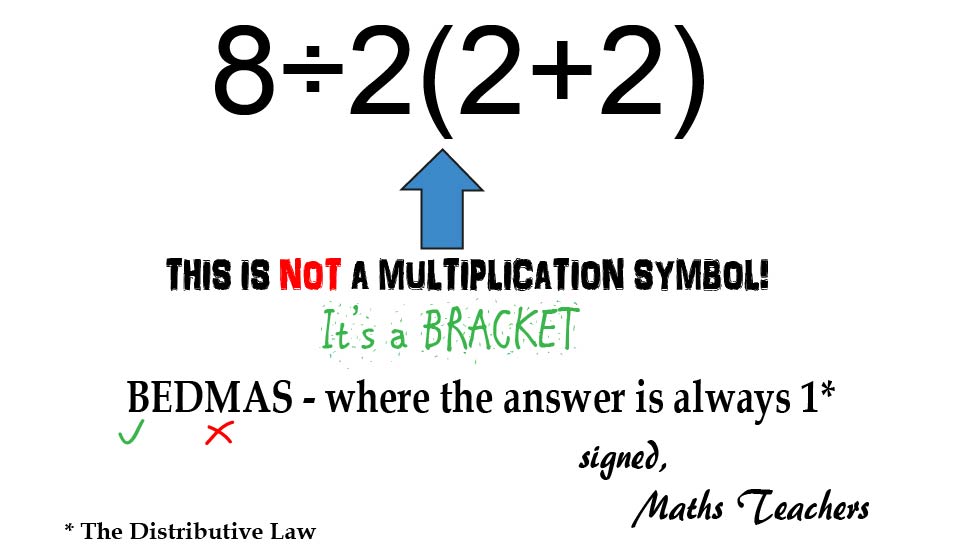-5**2 is apparently -25 because of the order of operations)
Which is correct
As a Maths teacher, almost daily 😂
Thanks for the effort!
You're welcome.
Just proves, never too late to learn :-)
I would have got 1 by doing 2(2+2) = 8 first. Not because of bracket but because of “implied multiplication.”
Yeah, right answer but wrong reason. There's no such thing as implicit multiplication.
What I am learning here: 8÷2(2+2) is not same as 8÷2×(2+2)
Correct, and that's because of Terms - 8÷2(2+2) is 2 terms, with the (2+2) in the denominator, but 8÷2×(2+2) is 3 terms, with the (2+2) in the numerator... hence why people get the wrong answer when they add an extra multiply in.
number next bracket is not the same as normal multiplication in rule book
Right, because it's not "multiplication" at all (only applies literally to multiplication signs), it's a coefficient of a bracketed term, which means we have to apply The Distributive Law as part of solving Brackets.
÷ & × have right of way rule with whoever is left most wins
Yeah, the actual rule is Left associativity, and going left to right is the easy way to obey that.
multiple always happens first. But apparently it’s what’s left side first
Multiplication and division are equal precedence (and done left to right) if that's what you're talking about, but the issue is that a(b+c) isn't "multiplication" at all, it's a bracketed term with a coefficient which is therefore subject to The Distributive Law, and is solved as part of solving Brackets, which is always first. Multiplication refers literally to multiplication signs, of which there are none in the original question. A Term is a product, which is the result of a multiplication, not something which is to be multiplied.
If a=2 and b=3, then...
axb=2x3 - 2 terms
ab=6 - 1 term

Ok, that's a start. In your simple example they are all equal, but they aren't all the same.
yn+y - 2 terms
y(n+1) - 1 term
y×(n +1) - 2 terms
To see the difference, now precede it with a division, like in the original question...
1÷yn+y=(1/yn)+y
1÷y(n+1)=1/(yn+y)
1÷y×(n +1)=(n +1)/y
Note that in the last one, compared to the second one, the (n+1) is now in the numerator instead of in the denominator. Welcome to why having the (2+2) in the numerator gives the wrong answer.
The y(n+1) is same as yn + y
No, it's the same as (yn+y). You can't remove brackets unless there is only 1 term left inside.
if you removed the “6÷” part. It’s
...The Distributive Law.
It doesn't make sense in BODMAS either. Expanding Brackets has precedence of... Brackets, not "multiplication" - "Multiplication" refers literally to multiplication signs, of which there are none in this question.
Well thanks to you too for a proper conversation. :-) There's a lot of people here wanting to pull out their pitchforks over the smallest thing.
e.g. you made a comment about teaching the "scientific" method to kids, and I can tell you as a teacher that we already do (but the OP never looked at any Maths textbooks, nor asked any Maths teachers) :-)
Yeah, they're doing an upgrade right now. Yes, it's the Maths explanation - -25 is the correct answer.